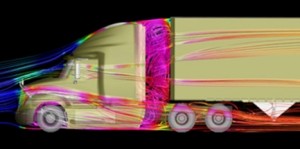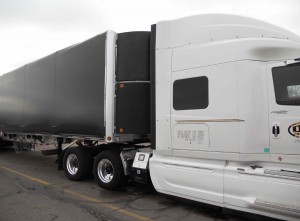 What contributes to fuel mileage in a semi-truck? Many people think it’s always the engine – change one part on the engine and miracles are supposed to happen (yes, if everything else is right on the complete rig, fuel mileage will improve). In general, there are two sides to this equation. The most common question we get here always starts out the same way, “What will my fuel mileage be if I…” This question cannot be answered accurately without knowing both sides of the equation.
What contributes to fuel mileage in a semi-truck? Many people think it’s always the engine – change one part on the engine and miracles are supposed to happen (yes, if everything else is right on the complete rig, fuel mileage will improve). In general, there are two sides to this equation. The most common question we get here always starts out the same way, “What will my fuel mileage be if I…” This question cannot be answered accurately without knowing both sides of the equation.
The first side of the equation involves the engine. This is where a truck transfers the chemical energy from the fuel in its tanks to rotational mechanical energy in the engine and then to kinetic energy as the whole truck builds momentum and it accelerates down the road. The more efficiently your engine converts this energy from one type to the other, the more you’ll save in fuel. It’s this side of the equation that we at Pittsburgh Power specialize in. Most of our articles deal with ways to generate more power with less fuel. But, this is only half of the battle to get great fuel mileage. In this month’s article we are going to talk about an important part of the other side of the equation, generically known as drag.
Drag is the only thing stopping your truck from rolling on forever after you get up to speed. Most people simply know of drag as a force that opposes movement and robs energy. There is a little more to it than that. Just like your engine doesn’t “make” energy – it converts it from one form to another – drag doesn’t truly rob energy, it converts kinetic and mechanical energy into heat. There are no exceptions to this. The more kinetic and mechanical energy your truck and trailer generate, the stronger the drag gets, and the faster the force of drag converts your energy to heat. What’s the easiest way to tell if your wheel bearings are failing? Just put your hand on the hub and feel for excess heat. The higher drag from a failing wheel bearing generates more heat than a healthy bearing.
When a truck is pulling a trailer down the highway, up to 65% of the total drag on the combination is produced by the trailer. Most of this is due to the tires, the wheel bearings and simple aerodynamics. So, think about your trailer – if you’re trailer’s tires are not the low rolling resistance type; if the wheel bearings are set too loose; if the axles are not in alignment with the king pin; if the load is heavy on the trailer axles; if the gap between the back of the bunk and the front of the trailer is more than 36 inches; or if the load is wide and has lots of openings (like bull racks or hay haulers), the drag will add up quickly and drastically and cost you money due to lowered efficiency.
 One way to decrease some of the drag caused by your trailer is a simple, new device called the Wind Blocker (see photo). This unique new product will increase your rig’s fuel mileage by about half of a mpg or more if you pull a van or a reefer trailer, or a flatbed or drop deck with a roll tarp. A roll tarp will decrease your mileage by half a mpg, but now you can get it back with the Wind Blocker. The Wind Blocker mounts to the front of the trailer and is adjustable – it helps fill the gap between the truck and trailer and helps to block the wind from creating drag on the front of the trailer.
One way to decrease some of the drag caused by your trailer is a simple, new device called the Wind Blocker (see photo). This unique new product will increase your rig’s fuel mileage by about half of a mpg or more if you pull a van or a reefer trailer, or a flatbed or drop deck with a roll tarp. A roll tarp will decrease your mileage by half a mpg, but now you can get it back with the Wind Blocker. The Wind Blocker mounts to the front of the trailer and is adjustable – it helps fill the gap between the truck and trailer and helps to block the wind from creating drag on the front of the trailer.
If you pull a company trailer, there isn’t much you can do to fix this problem (drag caused by the trailer). When it’s your trailer, you can work with it. The improvements you make will pay you back in fuel savings, for sure. Also, in regards to your alignment, stop by MD Alignment Service in Des Moines, Iowa, and if you get the chance to speak with Mike Beckett, do so. Listen to what Mike has to say – he’ll show you how to check you’re tractor alignment with a piece of string, a tape measure and a piece of tape! Mike can also tell you how to properly set the wheel bearings. And while you are there, let them do an alignment on your tractor – you will really feel the difference.
Speaking of the tractor, let’s talk a little about that. Are the tires on your tractor the low rolling resistance type? You will have to call the tire manufacturer for the resistance specs, as I do not have them. How are you geared? If you have a 13- or 18-speed transmission, you can be at your prime RPM all the time (if you have a 10-speed it’s not always possible because of the 500 to 600 RPM gap between the gears). What about the rear gears? 3:36 usually puts the truck in a lugging mode most of the time and is the hardest gear ratio on fuel mileage. We here at Pittsburgh Power prefer 2:64 gears. Many people think they will lose pulling power on the hills with 2:64 gears, but that is not true – you will actually gain power because the transmission is in direct gear and will deliver more power to the differentials because of a reduction in drag.
Now let’s go full circle, back to the engine. If you have an Acert Cat with a DPF, we can help you gain 1 mpg or more. It’s a lot of work, but we have taken a 2008 Pete with an Acert Cat and improved the fuel mileage from 4.2 to 6.7 mpg at 70 mph (if the owner drives by the turbo boost gauge the fuel mileage will go up to 7.3 mpg). If you have a DD5 Detroit with EGR, an ISX-EGR or an ISX-EGR-DPF, we can fix them all – and get you 1 additional mpg. There is no magic wand – it takes a few days in the shop and parts need to be installed, but your mileage will improve and you will have no more problems. Now, wouldn’t that be nice!
The 2002 and older engines require less work to produce more power and better fuel mileage, but don’t get discouraged if you love the new trucks – we can fix them, too! By reducing the drag on your tractor and trailer, dialing-in your engine’s specifications, and utilizing proper driving techniques, you can see amazing gains in your fuel mileage. For comments and questions, I can be reached through Pittsburgh Power Inc. in Saxonburg, PA by calling (724) 360-4080 or via e-mail at bruce@pittsburghpower.com.

1 Comment
This was a very interesting read on drag reduction. My uncle has been looking to install a sliding tarp system on his truck but has been wondering what effect that would have on his MPG. It sounds like there are some good options to make up any difference, like the Wind Blocker you mentioned. I’ll have to tell him to consult with a truck accessory company to see what their advice is in his situation.